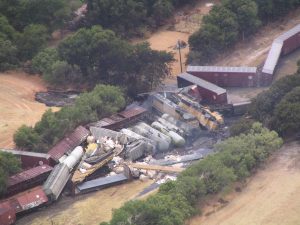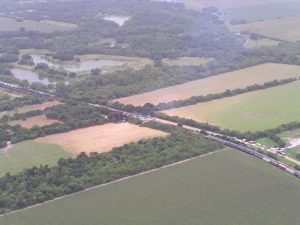Remembering a Chlorine Derailment
 It doesn’t seem like 13 years since I had a run-in with a railcar of “skull and crossbone” material. At that time I was a Federal On-Scene Coordinator (FOSC) with the U.S. EPA in Dallas, TX. FOSCs are the lead for agency responses to oil and hazardous substance releases and have full authority to direct all public and private resources to stop or prevent a release.
It doesn’t seem like 13 years since I had a run-in with a railcar of “skull and crossbone” material. At that time I was a Federal On-Scene Coordinator (FOSC) with the U.S. EPA in Dallas, TX. FOSCs are the lead for agency responses to oil and hazardous substance releases and have full authority to direct all public and private resources to stop or prevent a release.
On June 28, 2004 a pre-dawn train collision and derailment just outside of San Antonio released 60 tons of chlorine in less than three minutes. Misunderstood 911 calls sent first responders on a “smoke run,” nearly killing the first arriving units. Misinformation, fatalities, command conflicts, resistance by the railroad, extremely high-hazard entries, failed evacuation orders and hospitalization of at least 43 responders and residents combined to make this a unique and high-risk operation. It remains the largest chlorine transportation release in U.S. history, and the first from a head-puncture of a chlorine car, thought to be “impossible” prior to this (remember the Titanic?). Macdona, TX made it onto the map, but for the wrong reason.
The original 911 call gave the right information to two operators, but inexplicably neither heard her repeatedly mention a “big noise at the train track” and “I think the train has derailed.” She said “derailed” four times. Instead they picked up on “There’s smoke in my house.” We later recovered the caller and her elderly mother, both deceased in their home. The investigation found that 911 operators had neither training nor experience in hazmat incidents, so it appears they were focused on what they expected – smoke and fire – and that’s all they heard. They also later failed to execute an order for evacuation of approximately 57,000 residents. Fortunate wind shifts and dumb luck saved us on that one. Every hazmat responder knows that lack of information kills, and here was more proof.
This event was my first real use of ICS (Incident Command System). It is the standard in the response world now, but at that time was rarely seen outside of the fire service. Following our Shuttle Columbia recovery operation, EPA became an earnest adopter of ICS. My structure at Macdona included EPA, railroad, state and local authorities and a mix of contractors. It worked well, and I became a convert to its use.
On-scene there was immediate resistance from the senior Union Pacific official. He was uncooperative and intended to act against my specific direction, in my opinion endangering public health and welfare. Following a very adult conversation behind the trailer, EPA implemented our command structure and moved forward. I wasn’t going to need the U.S. Marshalls after all.
The heat was oppressive, especially for those working in protective

Wreckage and Chlorine Burn Area
clothing, and following a seemingly biblical rain event, rattlesnakes became a problem. There were tricky entry and plugging and patching operations. We made extensive use of remote sensing technology and roving air sampling teams, and no further releases occurred. The removal of 30 tons of chlorine frozen in the car used a first-of-its-kind technique, which sadly would be needed again only months later in Graniteville, SC.
I was proud of how so many diverse responders and support personnel came together on this response and did their job very well. In particular, I again thank Jeff Lewellin and my other colleagues, formerly at TCEQ, for their expertise and strong support – and enduring with great professional courtesy my unintentional taking over of their Mobile Command Post.
Following the response, there was a town hall meeting sponsored by U.S. Representative Charlie Gonzalez. With all of the drama, intrigue, stress, confusion and Type-A personality disorders involved, no one knew what to expect, but the consensus was that heads would roll. A woman in the front row had gotten there early and insisted vocally that she would go first, starting with me and the EPA. Once underway, I braced for the worst. She took the floor and pointed right at me, proclaiming to the crowd and the cameras that “EPA was our guardian angel.” I’ve been shot at, threatened and called many things doing response work, but her story of how we made her and hers feel safe and kept watch over them reinforced why we do what we do. That was the sole comment made to or about EPA that day. The remainder of the session was an epic bloodletting aimed at the railroad, the 911 operators and others, but it was mostly a blur for me after being promoted to angel.
Go to the EPA website and the lessons learned report prepared for the National Response Team for a close-up look at this unique event.
